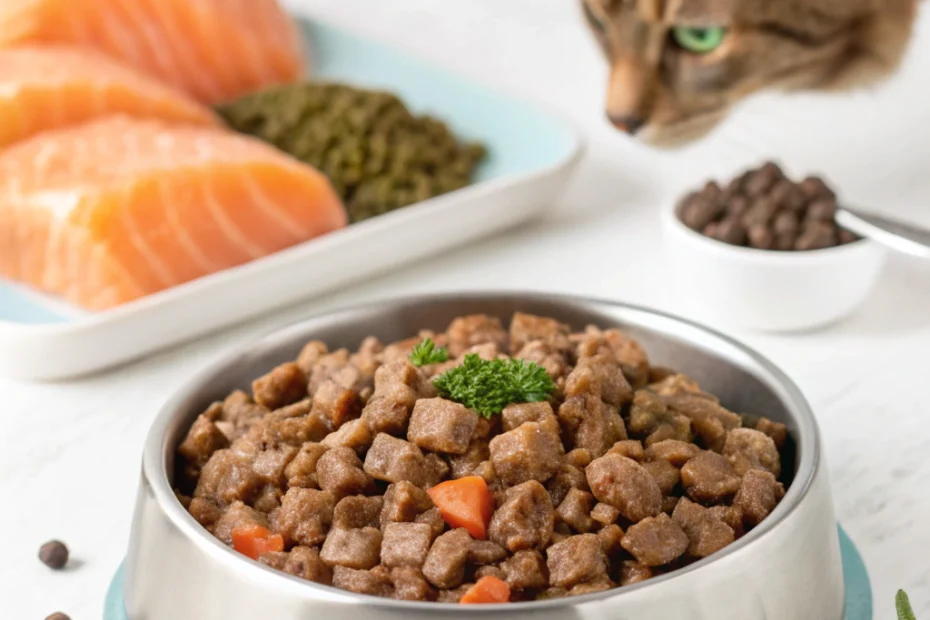At-a-Glance
Managing diabetes in cats can be a challenging task for any pet owner. One of the most critical aspects of managing this condition is choosing the right cat food for diabetic cats. This guide will walk you through the essential considerations and tips for selecting and managing your cat’s diet effectively. Understanding the role of diet in diabetes management can support your cat’s health and improve their quality of life.
How to Choose
Selecting the right cat food for diabetic cats involves understanding their unique nutritional needs. Diabetic cats may benefit from foods that are low in carbohydrates and high in protein. This type of diet can help stabilize blood sugar levels. When choosing a food, look for options that list high-quality protein sources as the primary ingredient. Avoid foods with high levels of fillers and carbohydrates, as these can cause spikes in blood sugar.
Consulting with your veterinarian is crucial when selecting a diet plan. They can recommend specific brands or formulations that are commonly used for diabetic cats. Additionally, consider your cat’s preferences and any other health conditions they may have. Some cats may require a prescription diet, while others might do well on a commercial option that meets their nutritional needs.
Safety & Setup
Safety is a top priority when managing a diabetic cat’s diet. Always introduce new foods gradually to monitor how your cat responds. Sudden changes can lead to digestive upset or fluctuations in blood sugar levels. It’s also essential to maintain a consistent feeding schedule. Regular meals can help keep your cat’s blood sugar stable throughout the day.
Ensure that fresh water is always available, as diabetic cats may be prone to dehydration. Monitoring your cat’s weight and condition regularly can provide insights into how well their diet is working. If you notice any significant changes in their health or behavior, contact your veterinarian promptly.
Core Pillars
The core pillars of managing a diabetic cat’s diet include consistency, quality, and monitoring. Consistency in feeding times and portion sizes helps maintain stable blood sugar levels. Quality involves selecting foods that are nutritionally balanced and appropriate for diabetic cats. Monitoring involves keeping track of your cat’s health indicators, such as weight, energy levels, and appetite.
Regular veterinary check-ups are also a cornerstone of effective diabetes management. Your vet can perform blood tests to assess how well your cat’s diabetes is being controlled and make dietary adjustments as needed.
Placement & Environment Tips
Creating a comfortable feeding environment can encourage your cat to eat regularly. Place their food and water bowls in a quiet, accessible area where they feel safe. Avoid placing food near litter boxes or high-traffic areas, as this can deter your cat from eating.
If you have multiple pets, ensure that your diabetic cat can eat without competition or stress. Consider feeding them in a separate room or using a timed feeder to manage meal times effectively. This can help ensure they receive the right amount of food without interference from other pets.
Comparison with Alternatives
When considering cat food for diabetic cats, it’s helpful to compare different types of diets. Prescription diets are specifically formulated for managing diabetes and may offer precise nutritional profiles. However, they can be more expensive than commercial options.
Commercial cat foods that are high in protein and low in carbohydrates can also be suitable for diabetic cats. These options may be more affordable and readily available. However, it’s essential to read labels carefully and consult with your veterinarian to ensure they meet your cat’s needs.
Homemade diets are another alternative, but they require careful planning and veterinary guidance to ensure they are nutritionally complete. This option may be suitable for pet owners who prefer to have complete control over their cat’s diet.
FAQs
Can I feed my diabetic cat regular cat food?
While some regular cat foods may be suitable, it’s essential to choose those that are low in carbohydrates and high in protein. Always consult your veterinarian before making any changes to your cat’s diet.
How often should I feed my diabetic cat?
Feeding schedules can vary, but many diabetic cats benefit from multiple small meals throughout the day. This can help maintain stable blood sugar levels. Your veterinarian can provide specific recommendations based on your cat’s needs.
What are the signs that my cat’s diet is not working?
If your cat experiences weight loss, increased thirst, or changes in energy levels, their diet may need adjustment. Consult your veterinarian if you notice any concerning symptoms.
What to Do Next
Now that you have a better understanding of cat food for diabetic cats, the next step is to consult with your veterinarian. They can provide personalized advice and help you develop a diet plan tailored to your cat’s specific needs. Remember, managing diabetes is a team effort, and your veterinarian is a valuable partner in ensuring your cat’s health and well-being.
Disclaimer: Always consult your veterinarian for personalized advice regarding your cat’s health.
